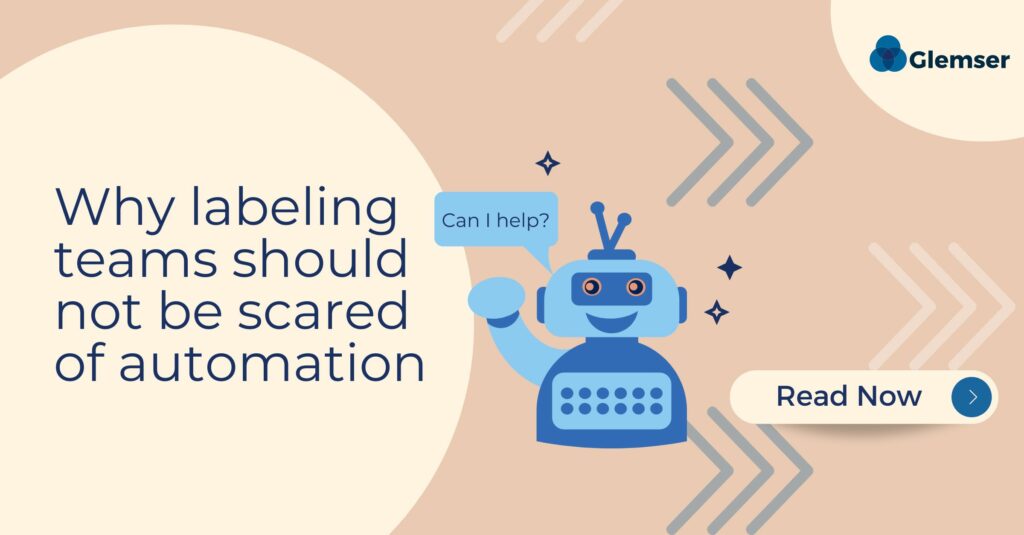
Every day we see articles related to Artificial Intelligence and Automation with a wide range of opinions on their safety and utility. Some tout revolutionary process improvements while others fear rogue AI attempting to rewrite critical content and push it out before anyone can review it. In the new world of AI, the underlying fear is typically the lack of human involvement and control.
Like most things, there are benefits and risks that must be taken into consideration, but when implemented properly, with the appropriate checks and balances, the opportunities are substantial and can be applied to a broad array of functions within the pharma world, including the end-to-end labeling process.
Balancing Benefits and Risks
The thought of implementing automation and especially artificial intelligence (AI) to the labeling process can be daunting as with any critical process, labeling needs to be adequately controlled. What could be more important than conveying the most basic safety and efficacy information to the users of our products? Companies follow strict regulations and requirements to create product labeling and provide many resources to ensure constant compliance. Even so, errors are occasionally made, which in turn result in additional checks and balances implemented.
Over the last ten years or so, most pharma companies have made extensive improvements to their labeling process as well as remediation of labeling content globally. The labeling process, however, for any global company is anything but linear and is in constant motion. It can be a complex spider web of processes controlling versions and relationships of multifaceted documents delivering approved labeling globally and locally.
How Automation Can Help
An important question often asked is how automation can help while assuring the same level of control currently in place. In many cases, automation has been deployed in the form of part number checking or the like when the labeling files are complete and moved into production.
There are a few key areas that instantly come to mind, including content generation and translations, which should be explored further with an eye toward opportunity to best harness new innovations and capabilities in the AI space.
In the initial content creation for product labeling, there are many standard terminologies and phrases that are always used, especially within a particular therapeutic area. An AI tool can digest and learn from a vast library of labeling to assist in further standardizing some of those, automatically inserting them into a labeling draft document and allowing the author to focus on other areas which need their attention. This can also streamline reviews as well while assuring that reviewers have the final decision on all content.
Considering the evolution of labeling creation from typewriters to Word Processing to templates and version control, the next level of automation seems a very natural transition to increasing our efficiency and control even further; while continuing to drive standardization where it makes the most sense.
Automated Translations
Once the content is created and approved internally by a core labeling team, translations come into play. In the last couple of years, the automation of translations has improved by leaps and bounds. Machine learning tools allow for the reuse of key phrases and terms as well as ensuring proper context and meaning for healthcare-related information. Many successful pilot projects have been undertaken with the delivery of increased speed and reduction of errors in the translation process.
As with anything new, proper testing and validation is needed. However, the potential is enormous. Think of the countless man-hours and third-party fees for the hundreds of translations needed. The ability to reduce the variation and potential errors with translation memory and structured content reuse only magnifies the value of machine language translation.
Future of Labeling: Imagining the Possibilities
Imagine an end-to-end labeling process where the author initiates a core labeling document utilizing component-based authoring and intelligent content generation to create and assemble a review copy in record time at the push of a button. Once the author is satisfied with their draft, it can be circulated for review transparently so that it becomes a collaborative effort of all relevant parties.
Once approved internally, translations occur seamlessly for partners and authorities around the world. Component relationships are maintained and updates managed effectively, all the while the AI tool continues to digest and learn preferences and requirements. Once ready for production, with the proper inputs, the artwork files are automatically generated quickly and efficiently. From there, the output can transition into production.
Changes and updates are much simpler to make in an ecosystem where component-based authoring is paired with an intelligent tool that can point to the appropriate sections and wording that need updates and translate those as needed.
Conclusion: Embracing the Future
That imagined future is now. The tools are available and with a knowledgeable partner in both process and technology, the future can be yours. The process and remediation work done over the last ten years, has amassed tremendous knowledge, gathered a multitude of documents into shared repositories, and laid a foundation for building an efficient, effective, and automated process to deliver compliant labeling rapidly.
While AI and automation on their own can appear to represent a huge shift, it really is nothing more than the next generation of excellence and state-of-the-art practices. When integrated with an end-to-end labeling system with the proper checks and balances, the results are well worth the effort.
Interested in introducing automation to your labeling workflows? Contact Glemser today to get started.


